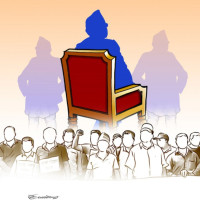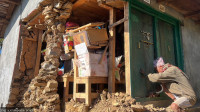Opinion
The South Asian narrative
I have always sought to interpret the complexity of the South Asian narrative in my own terms, not least in my experience of the idea gained over many years both as an academic and literary writer.
I have always sought to interpret the complexity of the South Asian narrative in my own terms, not least in my experience of the idea gained over many years both as an academic and literary writer. After so many years of experience and exposure, I have learnt to interpret the South Asian narrative, not only from the history and political texts, but also through the classics, mythologies and puranic precepts that I have derived from my mother, gurus, and books. In that process, I was struck by what I experienced this time at the South Asian Literature Festival organised by Foundation of SAARC Writers and Literature (FOSWAL) with a senior Punjabi writer Ajeet Cour as its chairperson, in Delhi from 4-7 October 2018.
Dynamics of cultural character
Ashis Nandy’s keynote remarks about South Asia impressed me. He said, South Asia is a bureaucratic idea, but, importantly, also a civilisational region and a cultural entity. Civilisation is three thousand years old whereas the nation-states are 70 years old. I recall here Nandy’s article published in Inter-Asia Cultural Studies under the eloquent title ‘The idea of South Asia: a personal note on post-Bangdung blues’. The post-Bangdung blues emanate from the nation-states always acting “as if they were fragile and facing collapse”. They have developed a sense of insecurity; each is saying, I am not the other neighbouring nation- state. The blues continue to haunt us all in this region.
The identity of Nepal and its historicity warrant mention here. It is a 250 years old nation-state counting from the year 1768 when Prithvi Narayan Shah of the house of Gorkha conquered Kathmandu. But one other interesting fact often ignored by historians and postcolonial analysts is that the British power in India was very much at the back of the king’s mind. The skirmishes that PN Shah’s soldiers fought with what they called the missionaries, a few times show the reason for that. The presence of the British in the South continued to dominate the psyche of the rulers obviously from Prithvi Narayan Shah who has mentioned that factor in what is called his wise exhortations or divyaupadesh, to his successors culminating in the Anglo-Nepalese war of 1814-1816. The best description of that spectre of British power and the narrative of the psychological grappling with that can be read in the most productive way in Charles Allen’s book The Prisoner of Kathmandu: Brian Hudgson in Nepal 1820-43. I have previously discussed in this newspaper about that book and the complexity of the psyche that haunted both the British raj and the Nepali state,. Nepal too evinced the psyche of defining itself as an independent state by using the British raj as alterity and colonial power for that purpose, though its historical condition was different from that of the other SA states. But Nepal was always part of what Nandy called the dynamics of the cultural character of the region.
Nandy said, the different nation-states monopolised different religions as their own, and they continue to enhance such ownership vigorously. He said, nonetheless, the old civilisation allowed values to survive. But for that survival the different forces of this region struck a tacit deal; they were united by that sense of civilisational and cultural bonding. He referred to the Ramayanic story of the construction of bridge sweatband rameshwaram by Rama’s soldiers to cross the sea to Lankain order to fight Ravana. After the construction was completed they needed a Brahmin to do puja to inaugurate it. Ravana who was the only Brahmana available in the entire region was requested to do the puja.
Disguised—though everybody knew he was Ravana—he came as a matter of ethics and performed the puja to open the bridge that invited the destruction of his family and him. Cultural bonding requires great hearts too.
The South Asian energy
Behind South Asia’s turmoil, writers get that very sense of dynamism and creativity. That sense of bonding, sometimes challenging to achieve, is always at the core of ‘South Asia’, which is a modern nomenclature. We see that the pattern of bonding in the subtle aspects of the culture that we share. But we have taken a tortuous path to achieve that. We have become reliant on the political and state forces to create an atmosphere for us to be able to share the bonding in South Asia.
However, vast body of scholarship has grown around the theme of South Asia. Seminars are organised and books written by scholars, mostly from India, along with scholars from other countries, are published each year. Universities give courses on different aspects of that complex identity. But how to grasp the amorphous South Asian identity is a pertinent question. Ajeet Cour chose a modality that I considered impossible initially. That was a path of anarchic relativism. I call that a path of serendipity, of doing it freely, creatively and informally as we go along. The following words Ajeet Cour said in her opening address capture that sense of creative elusiveness, serendipity and madness:
“When we look back, way back in 1986, the launching of a mad dream of catching that elusive golden sparrow called Peace in a rather turbulent region, through meeting of creative and sensitive minds, seemed really mad to everybody in power. … I launched my rickety boat in the turbulent sea with a Writers’ Conference in 1987, which became a milestone”.
Nepali participants that included professors of literature, poets and novelists, quiet productively became part of that informal, creative moment of historicity and dynamism. They met and interacted with writers from the South Asian region.
But I am not sure if Ajeet Cour’s method will be inherited as a model in this region to create an organisation that will bring writers and artists to achieve the purpose of foregrounding that South Asian energy. We live in difficult times. But I see opportunities also in those difficulties on one score. They show the path of writers and artists, theatre and cultural workers to come together to open up the path. Albert Camus said, create in perilous conditions. We are lovers of peace, non-violence, dedication and creative discoveries, which for me, constitute the soul of South Asia.




 18.12°C Kathmandu
18.12°C Kathmandu









